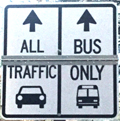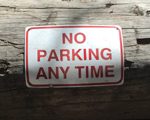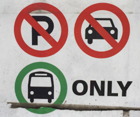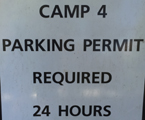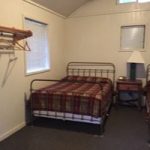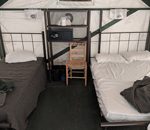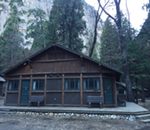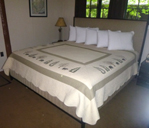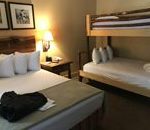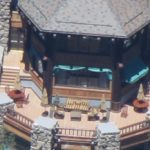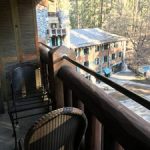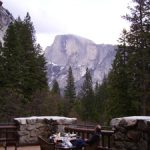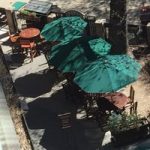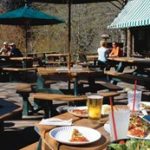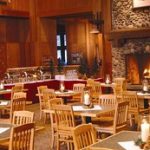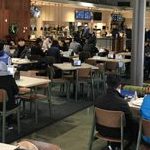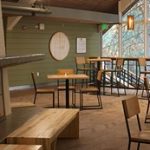This page has a link to bad weather driving tips, tips for using tire chains, tricks for dealing with frozen car locks, how to prepare your vehicle for winter driving, a winter survival kit for your car, what to do if you get stranded, how to keep windows from fogging up and tips for driving in snow and ice.
Safe driving in rain and fog includes info about driving in fog, on black ice, driving in rain, driving in floods (don’t) and chain requirements, with lots of links to follow.
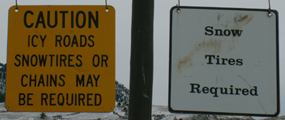
Using tire snow chains/cables
Not all vehicles have space between the wheel well and the big wheels for chains!
To extend the useful life of your chains read the manufacturer’s specs. They require that you drive at well below highway speeds. For example, the chains for our Jeep say to not exceed 30 mph. They require that you don’t keep the chains on the tire when you get to dry pavement. Our chains instructions say “Do not drive on dry pavement unless absolutely necessary and then only at minimum speed.” The speed limit in all posted chain control areas in Yosemite is 25 MPH and going much faster than that will wear out your chains faster anyway.
When using traditional link chain, prevent breakage by inspecting each chain carefully to remove tangles and twists before you put the chains on. Most broken cross chain is caused by driving on chains with twisted links.
Don’t ignore the rubber adjusters that came with the chains; use them to keep the chains on tight.
Make sure you got the right size and make it easier to install them when out in the weather by trying them at home first. If they don’t fit, don’t try to fix it by deflating the tires, even a little.
Pull off the road to a safe place to install or remove chains. Put on those extra gloves and jacket/snowpants before you start working to protect yourself from hypothermia and frostbite. A small insulated pad to kneel on is really useful. Hey, lots of people lock their keys in the running vehicle when they stop to put on chains! A spare set of keys in your or someone else’s pocket could be a wise investment.
Apply the chains as snugly as possible, then drive a short distance, pull safely off the road again and check them. One brand of chains says to stop and retighten chains within driving one mile. Read and follow the manufacturer’s specs.
Stay away from chain eating curbs. When accelerating, start slowly to avoid spinning your wheels.
Read the instructions, do they tell you to stop and retighten after 1/4 to 1/2 mile?
When you unpack at home, hose off the chains, let them dry, and spray them with an all-purpose lubricant, like WD-40, before you put them away so they will not rust.
Even if it’s daytime, if it’s a blizzard, use your emergency flashers.
You need good sunglasses for the glare off snow.
de-icing windshields
You’ll need a real windshield ice scraper (preferably plastic, not metal) and real deicer.
The Centers for Disease Control website warns:
“Never pour water on your windshield to remove ice or snow; shattering may occur.
On a budget? The Yosemite Daily report said: “Top off your wiper fluid reservoir with freeze-proof fluid, a few tablespoons of rubbing alcohol added to standard fluid works as well.”
Avoid getting gasoline or alcohol on your skin while de-icing and fueling your car or using a snow blower. These materials in contact with the skin greatly increase heat loss from the body.”
Wise winter travelers lift the wiper blades off their windshield as soon as they park, or at least before the snow starts, so the blades won’t be frozen on the windshield in the morning:
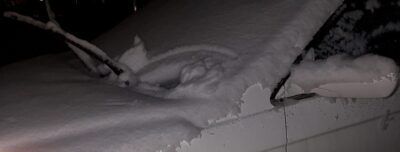
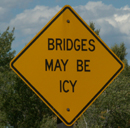
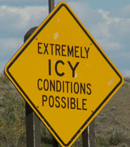
is the Cal Trans highway info page, just click on a route number for current conditions, closures, road construction slowdowns.
and Caltrans has lots of winter driving tips:
https://dot.ca.gov/travel/winter-driving-tips
__________________________________
Yosemite National park answers the question:
“Do chains make driving in snow easy?
Just because you have chains or four-wheel drive doesn’t mean driving in snow is easy. Even park residents who regularly commute on park roads during winter are involved in snow-related accidents. Follow these tips to reduce your chances of an accident.
The speed limit within chain control areas is 25 mph, even if other signs indicate the speed limit is higher.
And if I don’t put on chains?
You will be subject to a citation (up to $5,000) if you fail to put on chains when required. Further, if you don’t have chains with you, you may have to call a tow truck to supply chains for you (this could cost up to a few hundred dollars and is not covered by AAA; the wait can be several hours).
Countless accidents are caused by motorists who lose control because they don’t have chains, and many of those drivers have winter driving experience. Don’t be responsible for injuring someone, damaging vehicles, or inconveniencing hundreds of other park visitors by causing an accident: use chains when required and drive with caution.”
__________________________________
From the Yosemite Daily Report
“Here is a reminder of what those Chain Requirement signs mean.
Remember the posted speed limit in the park is 25 mph when Chain Requirements are in effect. This speed limit overrides all higher posted limits within the chain control area.
 R-1 Park signs read “AUTOS & PICKUPS SNOW TIRES OK”. This means chains
R-1 Park signs read “AUTOS & PICKUPS SNOW TIRES OK”. This means chains
are required for all vehicles unless they have snow tread tires. (4wdr without snow tires must chain up.) Snow tires must have a minimum tread depth of 6/32 of an inch to be legal.
· Studded snow tires may be used if the tires are also rated as snow tires, if not, the tires need to be chained up. (Studs do not replace chains!)
· Any vehicle with a gross vehicle weight of 6,000 lbs must chain up. (Usually, large vans on up.)
· All vehicles, including those with 4-wheel drive with snow tires that are towing trailers must have chains on one drive axle of the vehicle.
· If the trailer has brakes, it must also have chains on one axle.
 R-2 Park signs read “4W DRIVE WITH SNOW TIRES OK”. This means that
R-2 Park signs read “4W DRIVE WITH SNOW TIRES OK”. This means that
chains are required on almost all vehicles.
· The exception is four-wheel drive vehicles with snow tires on all four wheels. (This is for all 4-wheel drive passenger vehicles with an unladen weight of 6500 pounds or less)
· The 4wdr system must be engaged!
 R-3 Park signs read “NO EXCEPTIONS”. This means that chains are required
R-3 Park signs read “NO EXCEPTIONS”. This means that chains are required
on all vehicles.
· There are no exceptions. (Yup, “ALL” includes four-wheel drives, even with low range and even with a lockable center differential and even with snow tires.)
Remember, state law, in most states, requires you to carry chains in your vehicle when entering an active chain control area, even if they are not necessary yet. Even if the weather report for that day is for sunny weather.
More from Yosemite: https://www.nps.gov/yose/planyourvisit/tirechains.htm
__________________________________
My windows are fogging up faster than my navigator can wipe it off!
Yes, it’s cold out and you filled your car with people to share the trip expenses. They all are exhaling foggy breath, especially when you all sing along to that CD. Have them take turns holding their breath. Okay, maybe that’s not practical. Have them pay up for the gas expense in advance and let them off at the next bus stop. Unthinkable? The swimmers in the Outdoor Club know they can lick the inside of their swim goggles to prevent fogging, but a windshield…?
Not really practical either, well then…
Before the trip, use an ammonia-based window cleaner to energetically clean the inside of the window to remove the buildup of film the emanates from the plastics in the car. If you let anyone smoke in your vehicle…
The fog on the windows could be caused by trying to keep the car interior warm. When air is warm breath condenses, so stop and have your passengers put on those longjohns, jackets and maybe even hats, then keep the car cool. Even a few degrees will affect the maximum amount of water in the air quite significantly. With less water in the air the windows will frost up less.
Make sure your air conditioner or heater is in the fresh air position rather than recirc. The recirculate setting reuses the humid (moist) air already in the car. The air in the car is quite humid due to those mammals you are giving a ride to, and the outside air is less humid (even if it’s raining/snowing), so pull outside air in and push it against the inside of the window. And even though you are trying to keep the air in the main compartment coolish, the windows themselves need to be warmer than the cold air/rain/snow hitting them, so set the temperature to warm. Pulling in outside air has the drawback of sucking in truck or diesel exhaust, so pull back from that big rig or slowly, carefully go around it. Set the fan to its highest setting if you are going in slow traffic.
Now you can go back to your sing-along or heavy gossip session.
Next time you all get into the car, have each person take a seat, then kick their feet together outside of the car to knock excess snow off before they swing their legs in. Less snow melting in the vehicle also means less moisture in the car and less fog on the windows.
It uses less gas to drive with the air conditioning on than to drive with windows open.
Some people recommend wiping your windshield interior with shaving cream to de-fog it, but we do not because it can smell minty to the bears and they break into vehicles they can smell “food” inside of.
__________________________________
Driving on ice and snow
Slow down in advance of needing to hit the brakes.
Here in central valley and coastal California most of our roads will not freeze very often as the ground beneath doesn’t get that cold, so ice will only form occasionally in patches or after freezing rain.
But as you approach bridges, slow down. Black ice (a thin, invisible, complete coating of ice) forms on top of bridges, causeways or any stretch of road not paved over solid ground.
Likewise, shady places are icier than places where the sun can hit the pavement. Some sections of mountain roads will never get any sunshine due to the low angle of the winter sun.
Slushy conditions can be even icier than non-slush. Places where lots of people brake, such as intersections or hills, can get the ice polished by the braking. Slow down in advance of needing to hit the brakes.
Anticipate being rear-ended. Make your stops slow enough that the driver behind you can react properly. Be sure the seat headrests are installed and adjusted for your head(s). Anticipate people running red lights. Seatbelts really do save lives.
If following a car with a pile of snow on it, anticipate the snow sliding off and heading for your windshield. How much is your insurance deductable? Is it more than the cost of replacing a cracked windshield? Give that car in front of you space.
Even when it’s sunny and the road seems dry, you can slide and loose control on patches of sand put on previously icy places.
Experts tell you how to drive in the snow: http://exchange.aaa.com/wp-content/uploads/2012/12/AAA-How-to-Go-Ice-Snow.pdf
http://exchange.aaa.com/safety/driving-advice/winter-driving-tips/#.Wg23ZXZrzcs
On one snowy weekend in Yosemite, rangers responded to over 30 motor vehicle accidents, one with six people sent to trauma centers due to a SUV striking a tree, one involving eight vehicles and
an ambulance that slid off the icy road and two in which vehicles collided with NPS snowplows. One winter weekend Yosemite storm… has more.
There’s more at: Safe driving in rain and fog
The self-serve gas station at Crane Flat:
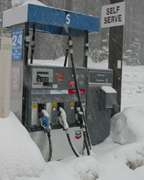
In cold weather, batteries are 50 per cent less efficient. Idling your car’s engine will charge the battery if the alternator and battery are in good condition. If either is slightly below par, or if the belt is just a little loose, idling may slowly discharge the battery, without turning on the charge warning light. Prolonged idling may drain the battery to the point that the car won’t restart. This means that if you didn’t pack enough proper gear to stay warm overnight on our snow camp trip, and you decide to try sitting in the car to warm up, with the engine running in the middle of the night, not only will you risk waking up everyone else, you could make it difficult or nearly impossible to start the car later when you want to go home.
If the owner of the Buick below had cleaned the battery terminals before the trip the half hour spent working on his car the last morning of the 2016 trip might have been used for something more fun.

We advise people to check everything that powers, stops, cools, heats, ventilates and lights their vehicle before they leave on an adventure. Road trip vehicle prep and recommended service has checklists (including many things people can do without a mechanic).
__________________________________
If it snows overnight while we are on this trip you will be able to get the snow off the vehicle much more easily if you cover it, or at least the windshield, with a big tarp. If you tow a utility trailer, (a big van full of passengers with their gear in a trailer is a great combo for this trip), you will really want at least a small cover for the trailer hitch area so you don’t have to clean snow off it at the end of the trip. Put something small (pieces of wood?) under each wiper blade while you are parked so they don’t stick to the windshield.
You should have just left the vehicle to sit at the campsite for the weekend, and ride the Yosemite Valley free valley shuttle bus and the free bus to the ski resort.
Clean the snow off the whole hood or it will slide and blow up on the windshield as soon as you drive off. Clean any snow out of the windshield air intake on the hood. Spray a little deicer on the windshield washer nozzles. Snow left on the roof will slide down on to the rear window, blocking visibility and the use of any rear wiper, or slide on the windshield the first time you hit the brakes. Clean any snow away from the exhaust pipe. Clean off all the lights. If you must bring some snow home for a snowball fight with your roommates, fill a now empty ice chest.
Make sure the windshield wiper blades are unstuck from the windshield before you start the car and try to use them.
Carbon monoxide poisoning can occur if you start a vehicle without clearing snow and ice from the tailpipe. And if the tailpipe is full of ice/snow, the car might not start at all.
__________________________________
Borrowing the family van for an Outdoor Club trip? You are probably used to driving a smaller vehicle and will need to take special care.
A U.S. Government study of accidents by forest fire crews found that human factors are the major contributing factor to motor vehicle accidents. Level of operator proficiency and experience in the vehicle type as well as fatigue were major problems. Unsafe practices included “talking on a cellular phone while driving and a driver removing an article of clothing while the vehicle was in motion” !!!
If you have ever found yourself distracted or subject to road rage, you’ll need to figure out ways to keep these things from happening. Let someone else change music tapes, talk on the cell phone or the borrowed family band radio. If your navigator can’t figure out the route, pull over to read the map.
The article stressed the consistent use of seat-belts, even at slow speeds. A vehicle driven on “a narrow mountain road at 5 mph went off the soft shoulder, rolled four times down a 50 percent slope into a steep ravine where the truck struck a large rock and landed upside down. The driver and passenger were wearing their seatbelts and walked away with minor bruises and abrasions”.
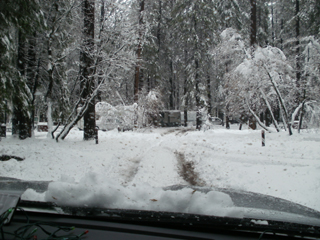
“Prepare Your Car for Winter
You can avoid many dangerous winter travel problems by planning ahead. Have maintenance service on your vehicle as often as the manufacturer recommends. In addition, every fall:
· Have the radiator system serviced, or check the antifreeze level yourself with an antifreeze tester. Add antifreeze, as needed.
· Replace windshield-wiper fluid with a wintertime mixture.
· Replace any worn tires, and check the air pressure in the tires.
During winter, keep the gas tank near full to help avoid ice in the tank and fuel lines.
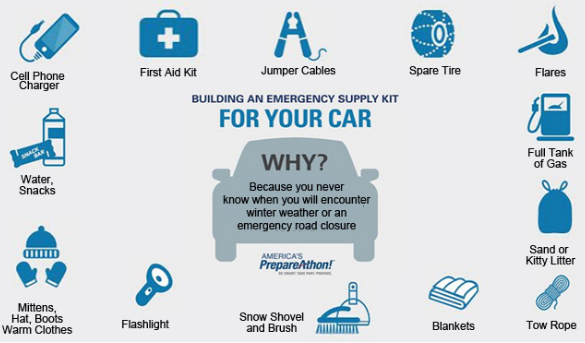
Winter Survival Kit for Your Car
Equip your car with these items:
·blankets
·first aid kit
·a can and waterproof matches (to melt snow for water)
·windshield scraper
·booster cables
·road maps
·compass
·tool kit
·paper towels
·bag of sand or cat litter(to pour on ice or snow for added traction)
·tire chains (in areas with heavy snow)
·collapsible shovel
·high-calorie canned or dried foods and a can opener
·flashlight (electric torch) and extra batteries
·canned compressed air with sealant (for emergency tire repair)
·brightly colored cloth”
“• Starting now, keep the gas tank at least half full. In winter it may be necessary to change routes, idle or travel slowly or turn back in a storm.
• Keep a snow brush and ice scraper in the car. Also, carry a clean cloth to “defog” and clean the inside of the windows.
• Do preventative maintenance. Make sure the brakes, windshield wipers, defroster, heater, lights and exhaust system are in top condition. Also, check the antifreeze level and tire pressure.
• Always carry chains. Remember chains must be installed on the “drive” wheels of the vehicle.
• Carry an extra ignition key. Many motorists lock themselves out of their vehicles when installing chains or attending to problems.
• Carry an emergency kit for winter. Items to include are: a flashlight with extra batteries, a first-aid kit, flares or emergency triangles, window washer fluid, jumper cables, a tool kit, a blanket or sleeping bag, gloves, paper towels, drinking water and energy bars. Also include, abrasive material such as sand, salt or non-clumping kitty litter and a small shovel. (Floor mats placed under the “drive” wheels can be used in an emergency to help free a vehicle.)”
What to Do if You Get Stranded
Staying in your vehicle when stranded is often the safest choice if winter storms create poor visibility or if roadways are ice covered.
These steps will increase your safety when stranded:
·Tie a brightly colored cloth to the antenna as a signal to rescuers.
·Move anything you need from the trunk into the passenger area.
·Wrap your entire body, including your head, in extra clothing, blankets, or newspapers.
·Stay awake. You will be less vulnerable to cold-related health problems.
·Run the motor (and heater) for about 10 minutes per hour, opening one window slightly to let in air. Make sure that snow is not blocking the exhaust pipe — this will reduce the risk of carbon monoxide poisoning.
·As you sit, keep moving your arms and legs to improve your circulation and stay warmer.
·Do not eat unmelted snow because it will lower your body temperature.
__________________________________
From the National park Service Daily Report of Feb. 1999
An Ernie’s Tours bus was eastbound on the Big Oak Flat Road in Yosemite NP when it rounded a curve on a downhill grade and came upon a stationary vehicle partially blocking the roadway. It was snowing heavily at the time, and the driver of the stopped vehicle was installing chains.
The bus driver locked his brakes while attempting to avoid the vehicle; the
bus went off the road, down a steep embankment, rolled, and came to rest on its side against a tree approximately 70 feet below the roadway. Rangers, firefighters and maintenance employees mounted a parkwide response. Seven of the 18 passengers were injured and required ambulance transport. Three other passengers, who initially denied being injured, were treated later that day. Most of the passengers were from Indonesia and had to delay their return home for several days because luggage and passports were inaccessible. Removal of the bus was impeded by continuing snowstorms. The road therefore had to be closed for two nights.
__________________________________
This page was compiled for the De Anza College Outdoor Club winter trip. There is more info at:
You might also want to read Snow chain rentals, wildlife jams
Snow camp carpools and driving directions also has the answer to the question: Which campsite do I park at?
Snow camp weather, hike safety and first aid considerations
Road trip advice and etiquette has practical advice from experienced and newbie carpoolers on cross country trips, including ways to keep from being so bored; planning before the trip; safety issues; drowsy driving; packing; road trip games, storytelling, debates and discussions; and links to gas price watch sites.
__________________________________
and perhaps of interest:
How to not collide with a deer,
– – – – – – – – – – – – – – – – – – – – – – – – – – – – – – – – – – –
Drivers should note that there have been sections of road in Yosemite Valley, part of the year, with two lanes (usually) in the same direction, with the right lane ONLY for the free shuttle buses, ambulances, ski bus, commercial vehicles with ten or more passengers. The NPS says: “The bus lane ensures emergency vehicles can respond to incidents when traffic is backed up and provides preference for mass transit.”
Parking and traffic jams in Yosemite valley tips and tricks has the above advice, with maps of each of the three major day-use parking lots, with advice to help you NOT get a Yosemite National Park traffic or parking ticket, and not contribute to preventable traffic backups. And some details of where you can’t park in Yosemite, or can’t park without a permit.
– – – – – – – – – – – – – – – – – – – – – – – – – – – – – – – – – – –
Road trip advice and etiquette has ideas for limiting boredom, getting along on a road trip and some packing and safety tips.
fatal, near fatal or close call incidents/accidents in camping, backpacking, climbing and mountaineering is a collection of some of the true stories I use in my wilderness first aid class to illustrate how the wilderness is not dangerous, it’s the people who aren’t prepared, who don’t know what they are doing, or who take inordinate risks, that are the danger.
Using a drone is illegal in Yosemite National park, including for photography. See an index to over a dozen park webpages with park laws, rules, regulations, policies and prohibitions about pets, bikes, permits, campground regulations, food storage, smoking, speed limits . . . and much more.
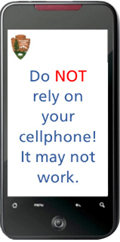 Your cell phone will not function in a lot of Yosemite.
Your cell phone will not function in a lot of Yosemite.
Cell phones in the wilderness has advice on how/when to use a cell phone to contact 911 in the wilderness and a warning about interference between cell phones, iPods and avalanche beacons.
Thunderstorm and lightning safety includes a warning about not using your cell phone or IPod during a storm.
The use of cell phones for photography (with or without a selfie stick) has made preventable injury or even death by selfie common They were just taking a selfie . . .
This warning from Canada can apply to any long-distance drive: “Visitors to large cities and popular tourist destinations should be aware that parked cars are regularly targeted for opportunistic smash-and-grab thefts, and they are cautioned to avoid leaving any unattended possessions in a vehicle, even in the trunk. Due to the high incidence of such crimes, motorists in Montreal, Toronto, Vancouver and some other jurisdictions can be fined for leaving their car doors unlocked or for leaving valuables in view. Visitors should exercise precaution to safeguard their property.”
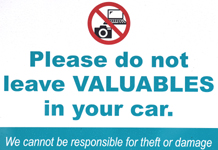
– – – – – – – – – – – – – – – – – – – – – – – – – – – – – – – – – – –
You have a number of lodging choices of where to stay overnight in Yosemite Valley in Yosemite National Park,
(not all of which are open all of every winter)
including campsites or
wood-walled cabin without a bath; heated or unheated wood floored, canvas sided and roofed tent cabin; wood walled cabin with a bath
luxury or generic hotel rooms, suites with a bath
__________________________________________
You can find basic to extravagant, (a few with a dress code),
casual, fast (grab and go)
or with table-side service,
indoor and outdoor food service
at multiple locations in Yosemite Valley, as well as four grocery stores
all of which are served by the Yosemite valley free shuttle bus.
